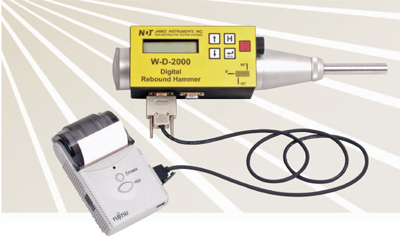James Digital
Test
Hammers
Digital hammers
for the quick and easy determination of the strength of concrete.

James Instruments digital test
hammers are an advanced, completely automated system for estimating
concrete compressive strength. Its calculation, memory and recording
functions allow for quick, easy and accurate test results.
Discard values for multiple test
results can be set; the mean, median and compressive strength can also
be calculated. The addition of modern microprocessor technology allows
the data to be stored, printed and transferred to a personal computer
for further analysis, or inclusion in your reports.
The unit comes with an integrated
alpha numeric digital display, and control panel. You can switch
between standard or metric units.
The field printer mounts on the
belt for ease of use.
USB Connection to a personal computer is via the USB interface.
Digital Model
W-D-2000
Automatic calculation of
mean rebound number, compressive strength and more; Field Printer, PC
connection and software for downloading
.
Digital Model
W-D-1500
Automatic calculation of
mean rebound number, compressive strength and more; Application: Rapid
estimate of concrete strength
.
|
ASTM
C-805
|
USA
|
|
BS-1881-202
|
Grt.
Brit.
|
|
ISO/DIS
8045
|
Intl.
|
|
EN
12 504-2
|
Europe
|
|
ENV
206
|
Europe
|
|
NFP
18-417
|
France
|
|
B
15-225
|
Belgium
|
|
JGJ/T
23-2001
|
China
|
|
JJG
817-1993
|
China
|
Specifications
|
Display:
|
2x16 Trans reflective
|
|
Construction:
|
All
Aluminum for rugged construction environment
|
|
Operating
Temperature:
|
0° to 50° C (32° to 122° F)
|
|
Batteries:
|
2 AA
|
|
Ap. Size:
|
100mm x
100mm x 270mm ( 4 x 4 x 10 )
|
|
Ap. Weight:
|
1.6 Kg ( 3.5 lbs.)
|
|
Printer
Size:
|
64mm x
49mm x 31mm
( 2.5 x 1.9 x 1.2 )
|
|
Weight:
|
up to
0.270 kg ( 0.6 lbs ) with paper
|
|
Battery:
|
Internal
Lithium ion with 1 yr. approximate life
|
|
Charger:
|
100VAC
240VAC 5 VDC 3.0A
|
|
Operating
Temperature:
|
0° to
50° C (32° to 122° F)
|
|
Software
|
Windows
PC Compatible / USB interface required
|
|
Impact Energy
|
2.2 Nm
|
Digital
and manual
schmidt concrete test
hammers for quick and easy determination of concrete compressive
strength. Available in 'N' and 'L' type.
Q. Unit gives
low or high readings
?
A. Unscrew cap on top of unit, there
is a screw in the cap. Adjust the screw up or down and check reading
against test anvil.
Q. Unit will not
fire when depressed
?
A. Make sure cap screw is in the
proper position. Check to make sure trigger spring is present. Check
for plunger spring in tip
Q. My first reading
was very low, but the readings after that are consistent
?
A. Disengage hammer and let it sit
before taking your first reading.
Q. How many
readings should I take in one particular area?
A. You
should take 10 readings, if you have any large deviation, exclude them
and take additional readings.





